Table of Contents
For brands, it’s increasingly important to find a way to cut through the noise of hashtags on social media and create a hashtag for your brand that is strong and relevant. So in this post, we’re going to detail how you can create a hashtag for your brand, as well as examples and guidelines.
Hashtags are everywhere you look – from social media feeds and TV ads, to billboards and city buses. But do you know how to create a hashtag for your brand? Let’s take a step back: what is a branded hashtag?
Definition: A branded hashtag is a hashtagged phrase used on social media that’s associated with a specific brand. It should be a phrase or word that inspires people to get a brand involved in the conversations that they’re having on platforms like Twitter and Instagram. In fact, using the right hashtag is a crucial aspect of Instagram marketing.
Here are the 9 points that we’re going to talk through that can help you to understand how to create a hashtag…
Many people ask, is it possible to register a hashtag? And the answer is yes! However, this doesn’t mean that other people can’t use it. It just means that you will be added to the hashtag directory of being associated with that specific hashtag. You can do that by following these steps…
Plus, stay tuned because in this blogpost, we’re going to be talking about these successful hashtag campaigns…
Now, let’s go a little deeper into how you can create the perfect hashtag for your brand.
Knowing how to create a hashtag is one of the most powerful tools you can have in your marketing arsenal. With it, you can connect with your audience more easily, get discovered by new potential fans, and track and curate what people are posting about your brand.
For example, in a case study for Kalevala, this Finnish jewlery brand demonstrates how they improved their engagement and reach by collecting customer content with their products through their brand hashtag. Their first step was, of course, to develop the perfect hashtag to represent their brand and intrigue their customer base.
Easy enough, right? How hard can it be to come up with something that’s only a few characters long? Well… pretty hard. Those deceptively simple hashtags you see catching on like wildfire actually take time and effort to create.
Figuring out how to create a hashtag that’s clear and branded is a common challenge we see with our clients. They’re using Flowbox to collect and showcase the photos that customers are posting of their products across social media – letting these images sing their brand’s praises. But this requires one very important element: the right hashtag that people will remember and actively use.
Too general and it gets lost in the shuffle with similar topics. Too niche and it’s hard to remember. Too complicated and no one can get the spelling right. But don’t worry if that sounds like an intimidating prospect. In this article, we’re going to go over everything on how to create a hashtag for your brand – the prefect hashtag. Using advice from experts, which you can read for yourself through the whitepaper below, we deduced these crucial tips to creating a branded hashtag.
Using hashtags offers several advantages for brands in today’s digital landscape. Hashtags serve as powerful tools for increasing brand visibility and reach by categorising content and making it discoverable to users interested in specific topics. By strategically incorporating branded hashtags into their social media posts, brands can enhance brand awareness and foster community engagement as users participate in conversations around their products or services.
Hashtags also enable brands to amplify the reach of their marketing campaigns, making it easier for users to find and engage with branded content. Furthermore, through the use of trending hashtags, brands can stay relevant and capitalize on current events and conversations, further increasing their visibility and engagement on social media platforms. Leveraging hashtags effectively allows brands to extend their digital presence, connect with their target audience, and drive meaningful interactions, ultimately contributing to their overall marketing objectives.
Flowbox is a versatile platform that allows businesses to gather UGC by leveraging hashtags. By encouraging customers to post content featuring a specific hashtag on social media, Flowbox can automatically collect and curate these posts. This enables brands to easily display authentic, engaging content on their websites or marketing campaigns. The integration of UGC not only enhances the credibility of the brand but also fosters a community of loyal customers who actively participate in promoting the brand. Additionally, Flowbox’s tools allow for seamless moderation and analytics, ensuring that only the best content is showcased.
Before we walk you through how to create a hashtag for your brand, here are some hashtag best practices to keep in mind. Take a look at the list below:
By following these best practices, you can effectively leverage hashtags to increase the visibility of your content, reach a wider audience, and drive engagement on social media platforms.
For every spot-on, “I wish I’d thought of that” hashtag on social media, there are countless others that miss their mark entirely. So what makes one hashtag a runaway hit and another instantly forgotten? What qualities go into a great hashtag? Let’s take a closer look at the 10 rules of thumb to successfully create a hashtag for your brand.
The first thing that’s important to mention is that you are going to have a lot of mediocre to bad ideas when you first start figuring out how to create a hashtag. Expect it, and prepare for it. There’s a reason there are so many “meh” hashtags out there: some frazzled social media manager or marketing director on a deadline published the first idea that came to mind.
But you’re going to move past this phase and get to the good stuff.
Give yourself room to get these lackluster hashtag ideas out of your system. However you work best – whiteboard brainstorming, mind-mapping, old-fashioned doodling – write them all down. Don’t censor yourself in this phase, even if you’re embarrassed by some of your half-baked ideas.
Start with the obvious words associated with your brand, your products, your industry. Look at your competitors and see what they’re doing. Play with word and phrase combinations, then take a break if you can. Go marinate on the ideas you’ve come up with, then come back with fresh eyes later.
What is it that you want your customers to do with this hashtag?
Will they be taking selfies wearing the sunglasses from your new collection? Will they be posting pictures of the recipes they made with your baking equipment? Put yourself in your customers’ shoes, and focus on creating a hashtag that you can actually see them using.
Separate themes into different categories, and pay attention to the ones that catch your attention. Look at them as building blocks, and see how you can tweak and combine them for improvements.
For a very broad hashtag that could belong to any brand, how could you make it more tailored to your company or customers? For a hard-to-get hashtag, how could you open it up to make it more understandable?
Remember which characters are allowed in a hashtag as well: letters and numbers are fine, but punctuation marks (commas, periods, exclamation points) and special characters (asterisks, ampersands, dollar signs) are not. But you can use emojis in hashtags!

Don’t forget, these days the best hashtag for your brand, when it’s not connected with an over-arching campaign, could just be your brand name.
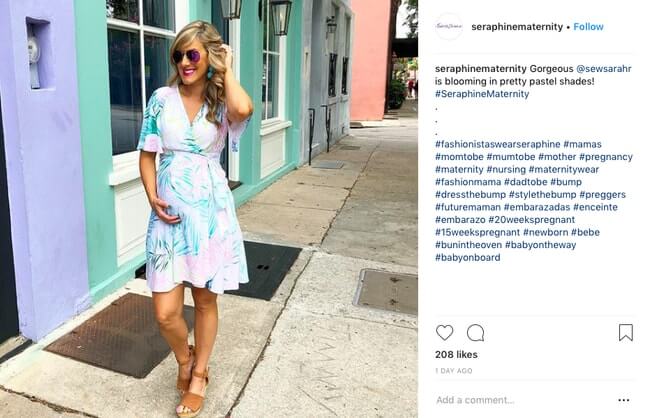
This keeps things simple, while not necessarily drawing people in to post. But with the right promotion within your marketing strategy, it could still be the right way to go!
The whole point of your hashtag building mission is to earn the attention and engagement of your customers. Keep them central to your efforts.
What do you already know about them? What do they like and dislike? What do they already talk and post about on social media? How do you think they will react to each hashtag you’re considering?
A hashtag has to be relevant to your community, or it will be met with confusion, annoyance or disdain. Show that you get them.
And make it clear that your brand will repost and give some social media love to the best User Generated Content. This is a win-win for both of you: your customers get exposure and potential new followers, and you, of course, get great authentic content.
If you’re struggling to get specific with your audience, try an exercise that will get your mind in the right place – it will be worth it for the rest of your hashtag efforts if you do so!
There are exceptions, but most effective hashtags are concise and easy to understand at a glance.
Clarity is key. You won’t have time to explain a convoluted hashtag – your audience will have already moved on by then. Don’t be so focused on cleverness or creativity that you confuse people.
Play with a short phrase or just a few words. If you have a concept you love that’s too wordy, look for other ways to express it. Pare down that vocabulary, and get lean.
Target uses tons of hasthags to promote their wide variety of products. But one of their most popular is the classic #TargetRun.
Target runs are not only something that people do constantly, but they also love doing it. And the hashtag is a perfect way to encapsulate the fun of going to Target! When people identify with the experience that your hashtag represents, they’ll be more likely to post with it.
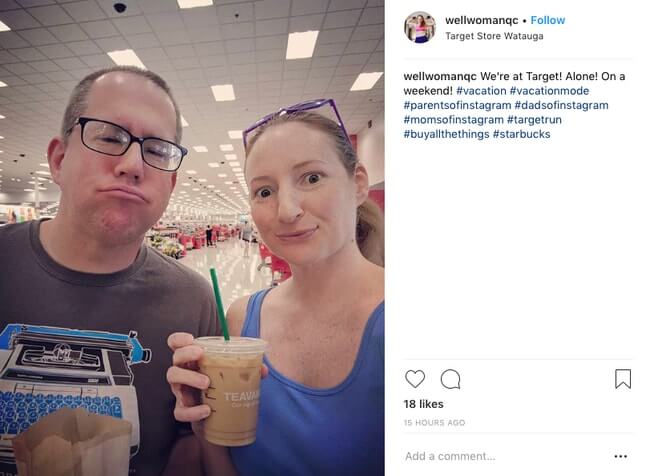
Red Bull’s #PutACanOnIt campaign was inspired by a customer who posted a photo of a Red Bull can held above a Mini Cooper, making it look like it was the signature brand car. The brand asked other customers to get in on the silly fun, posting their own #PutACanOnIt photos, and the campaign won a Shorty Award for “Best Use of a Hashtag.”
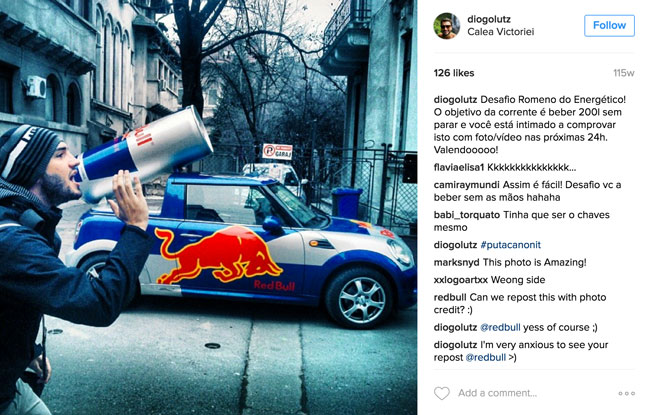
Simplicity is important in creating a hashtag, but that doesn’t mean you can’t explore more complex emotions and experiences. A hashtag that evokes a strong reaction or feeling in your audience is memorable and powerful – even if it doesn’t explicitly mention your company name at all.
Take a cue from brands that have done this brilliantly:
REI took a major risk when they told customers not to head out to their stores on Black Friday but instead to #OptOutside. And it turns out, they know their customer base really well! The campaign turned out to be a major success and is still being used as their branded hashtag.
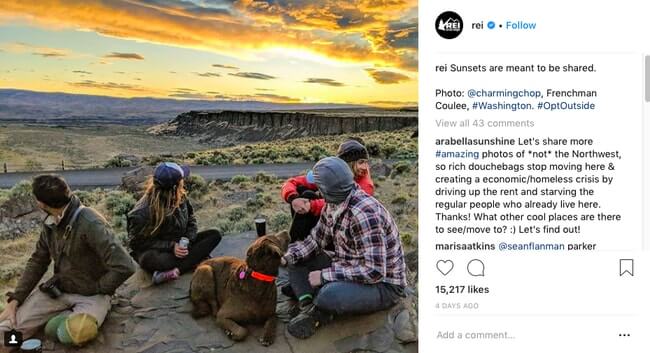
Athletic clothing company lululemon continuously encourages customers to post photos of themselves with the hashtag #thesweatlife. The photos customers publish range from serene yoga poses to hardcore kickboxing workouts – but all evoke the feeling of a healthy and active lifestyle, one that can be hard but truly pays off.

Narrow down your favorite hashtag ideas, and put together a short list of contenders. Once you have a solid selection, take time to research them thoroughly on social media. You’re looking for a hashtag that’s strongly associated with your brand, that you can track and monitor. For that to work, you want a hashtag you can own.
Are individuals or brands already using your ideas on any platform? If so, were they one-off posts or associated with a campaign?
The last thing you want is to unwittingly co-opt an existing hashtag – especially one that has nothing to do with your brand. This can be frustrating at best, or a PR disaster at worst.
It pays to do your homework – understanding what hashtags already exist and what they mean. Avoid ending up a cautionary tale like these brands; humiliating mistakes can be avoided with even cursory hashtag research.
DiGiorno is known for its quick-witted social media presence, but in this case, it was a little too fast on the draw. In 2014, #WhyIStayed was a trending hashtag. A video of an NFL player assaulting his wife had been leaked online, sparking an emotional conversation about domestic violence. People were using the hashtag to discuss the reasons they stayed with abusive partners, but DiGiorno used the hashtag for this tweet:
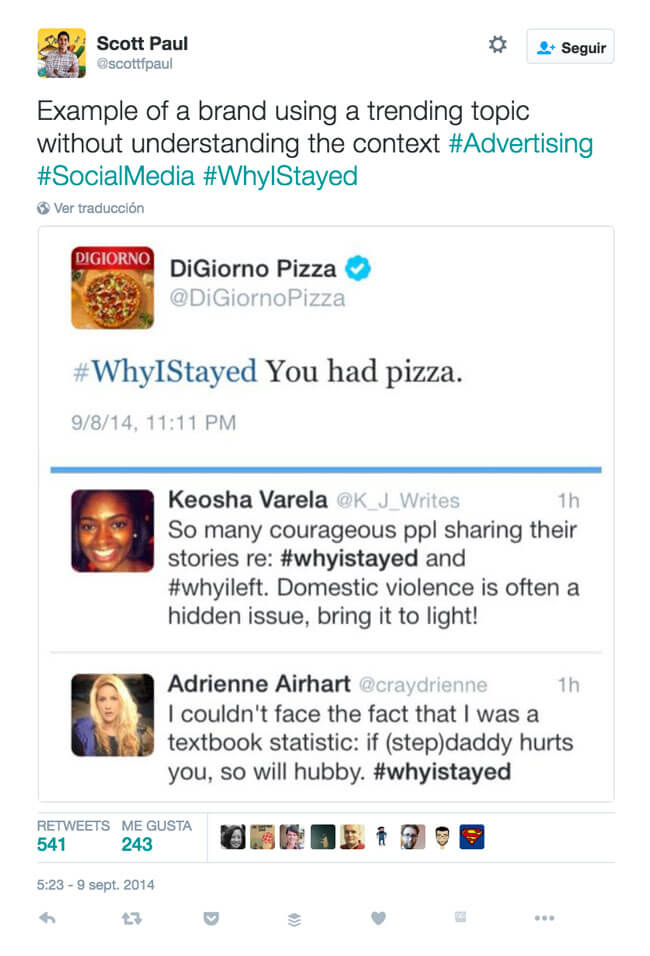
Naturally, it did not go over well. There was immediate backlash from people who accused the brand of mocking the plight of abuse survivors to promote its products. Not at all the kind of attention you want for your brand on social media.
DiGiorno apologised profusely, but the gaffe made the company look either extremely careless or intentionally insensitive.
Greyhound bus attempted to be hip and in the know with this hashtag, intended to mean: “fear of missing out on Greyhound low fares”. Even though this was meant to be tongue and cheek, the brand still really missed the mark. This abbreviation is way to confusing and not related to anything in particular for anyone to actually use.
And that’s why the hashtag only has 2 posts on Instagram – one from the actual brand and one that is clearly making fun of their attempt to reach audiences.
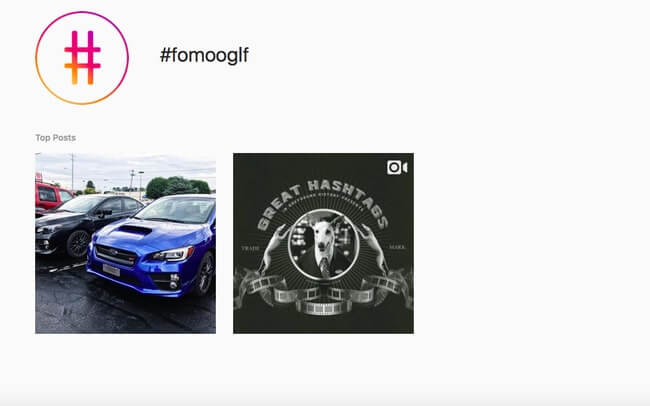
This is another crucial step you can’t afford to skip. Examine your hashtag closely for any possible problems.
Write it out in all lowercase characters. Read it out loud. Ask other people on your team to do the same. Note where you stumble or have to do a double take.
Ask different people to write the hashtag when you dictate it to them (without them seeing it written down). Does anyone struggle with its spelling, pronunciation or meaning?
When Margaret Thatcher died in 2013, an ambiguous hashtag caused the Internet to believe another famous person had died. The hashtag #NowThatchersDead could also be read #NowThatChersDead, spreading rumors that about the singer’s death, when she was very much still alive.
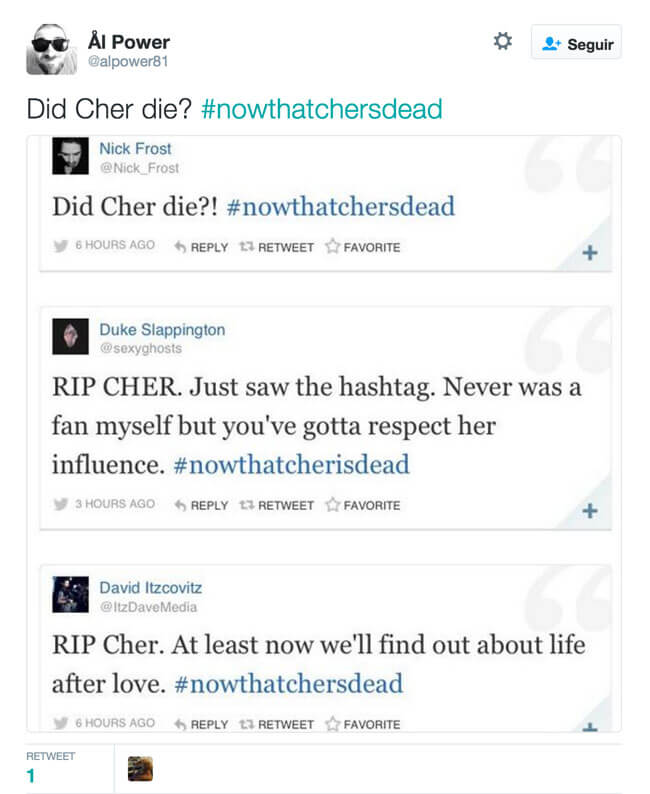
This is also a time when it pays to be completely immature. Give yourself permission to put your mind in the gutter.
Look at your hashtag from the perspective of a 13 year old or the most sarcastic person on social media. Is there any way it could be misinterpreted or read differently than you intend? Is there any innuendo or association hidden in that hashtag that will come back to haunt you later?
Before you open your hashtag up to the public, run it by a few key people outside your team first. Do a gut check with people who are representative of your target audience – especially across languages, cultures, age groups or other important demographics.
Do they get it? What does it mean to them? Can they see themselves remembering and using it?
Once you have their buy-in, you can move forward with more confidence.
Congratulations! You’ve mastered the art of hashtag building, and you’re ready to release your creation out into the world. In order to get people to use – you have to! So put it everywhere. In emails, on your website, all over Instagram! The more you promote its use, the more people will feel encouraged to share because they too want to see your brand feature their photos.
Follow the example of brands like DENHAM The Jeanmaker – they encourage customers to post with their hashtag directly on their website.
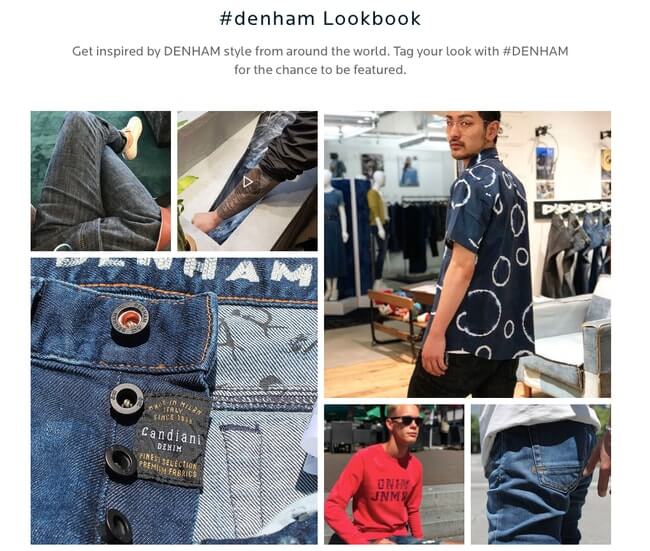
The more you use it, the more your loyal customers will. So keep up the effort and get the word out!
Some of our clients benefit from the addition of a dedicated community page on their wesbite that features a UGC gallery and an explanation of how they can share their content too and the correct hashtag to use.
A dedicated community page with UGC on a company’s website offers a myriad of benefits for both the business and its customers. Firstly, it fosters a sense of belonging and engagement among customers, transforming them from passive consumers into active participants in the brand’s ecosystem. By providing a platform for users to share their experiences, opinions, and insights, businesses can tap into valuable feedback and gain a deeper understanding of their audience’s preferences and needs. This authentic interaction not only strengthens brand loyalty but also enhances credibility, as potential customers are more likely to trust the opinions of their peers.
A vibrant community page can serve as a hub for valuable consumer content, such as reviews, testimonials, and product recommendations, which can significantly influence purchasing decisions and drive conversions. By cultivating a thriving community on their website, businesses can build stronger relationships with their customers, drive brand advocacy, and create a dynamic digital presence that sets them apart in the competitive landscape. This is also the perfect place to promote your hashtag.
Take a look at the example of a community page on the Misako website below:

Want to leverage social media on your website like the brand above? Book a demo of the Flowbox platform to learn more about how you can leverage hashtags and UGC in your marketing strategy.
Now that you know how to create a hashtag, you can move on to checking it’s impact. Checking the effectiveness of a branded hashtag involves various metrics and strategies to gauge its impact on brand awareness and engagement. Monitoring the volume of posts using the branded hashtag across different social media platforms provides insights into its reach and popularity. Tracking UGC associated with the hashtag allows brands to assess the level of community engagement and user participation.
Instagram analytics are useful here, metrics such as likes, shares, comments, and impressions on posts featuring the branded hashtag helps evaluate its effectiveness in driving user engagement and interactions. Utilizing social media analytics tools and monitoring sentiment around the branded hashtag can further provide valuable insights into how it resonates with the target audience. Moreover, conducting periodic assessments of the branded hashtag’s performance and comparing it to predefined objectives allows brands to refine their hashtag strategy and optimize its effectiveness over time, ensuring it continues to contribute positively to their overall marketing efforts.